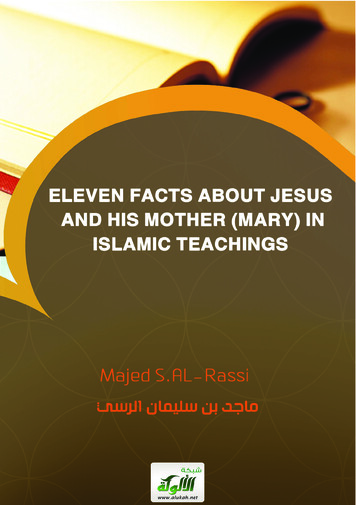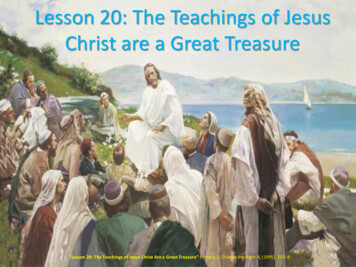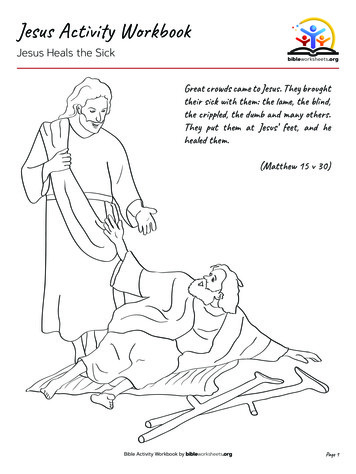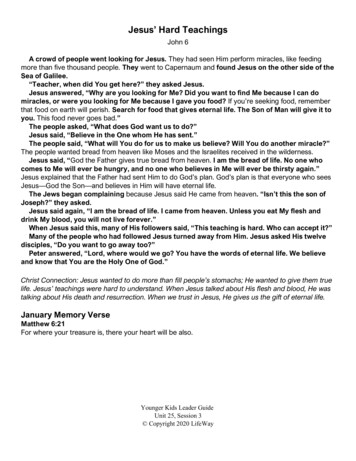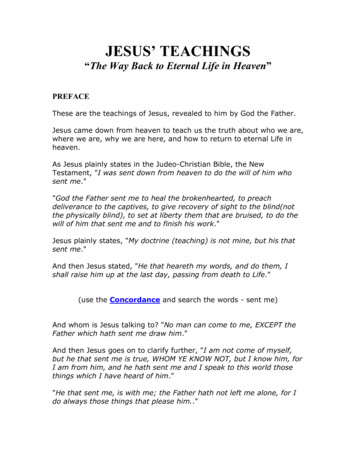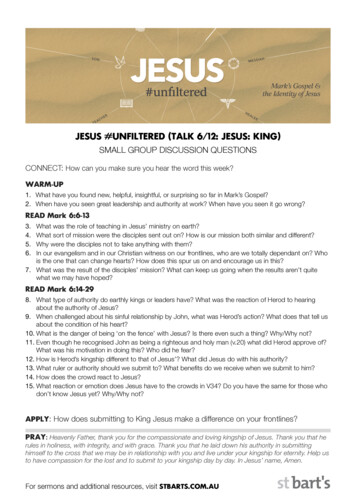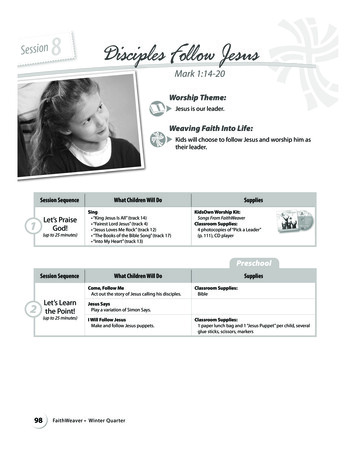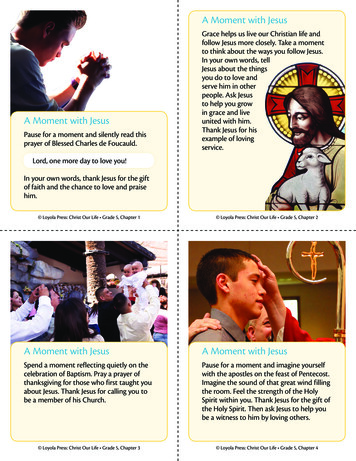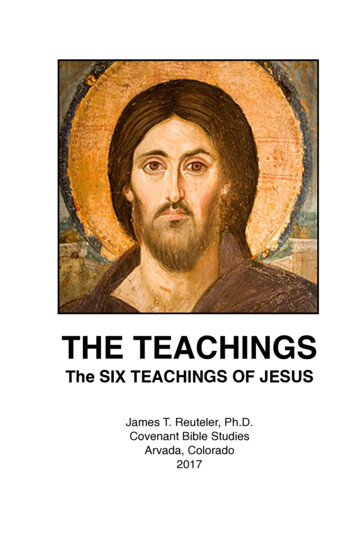
Transcription
THE TEACHINGSThe SIX TEACHINGS OF JESUSJames T. Reuteler, Ph.D.Covenant Bible StudiesArvada, Colorado20171
Dedicated to my WifeBarbara Ann (Russell) ReutelerSt. Catherine's on Mt. Sinai in Egypt is the oldestcontinuously operating monastery and home to one ofthe largest collections of Coptic manuscripts andpriceless paintings, such as this painting of Jesus,whichI have placed on the cover.2
TABLE OF CONTENTSINTRODUCTION ---------51. The Messianic Claim -------------------------------------------72. The Kingdom of God-----------------------------------------233. The Cost of Discipleship -------------------------------------334. The Law and Gospel -----------------------------------------495. The Spiritual Disciplines ------------------------------------616. The Apocalyptic Message --------101Jesus claims to be God ng the Kingdom es ---------108Three Characteristics of a True Christian -----------------109Obeying God’s Laws -------------------------------------------110The Ten Commandments Contrasted -----------------------111Salvation through Christ Alone ------------------------------112The End of the World ------------------------------------------113OTHER BOOKS BY THE AUTHOR --------------------------------1153
4
INTRODUCTIONThe teachings of Jesus have always fascinated me. While theessence of his teachings can be found in The Sermon on the Mount inchapters 5 to 7 of the Gospel of Matthew, there are valuable teachingsto be found in all the Gospels, in The Book of Acts, and even in theBook of Revelation.1 I have worked through all of these bookssearching for the Teachings of Jesus.I found six of Jesus’ teachings. They are his Messianic Claim, theKingdom of God, the Cost of Discipleship, the Law and Gospel, theSpiritual Disciplines, and the Apocalyptic Message.The New Testament is a companion to this book. It will benecessary to read the Scripture passages before reading my commentsor commentary on those passages. This book is not Scripture, but it is ameager attempt to interpret Scripture. In the Appendices, I have placedsome documents or graphics as an additional way of looking at someof the topics raised in the Six Teachings of Jesus. There may be morethan six categories of Jesus’ teachings, but these are the six categoriesthat have leaped out at me.Why is it important to study the teachings of Jesus? In my opinion,these six categories of his teachings should be studied first. We shouldread the Bible backwards, starting with Jesus and interpretingeverything else from our understanding of Jesus. This means of coursethat parts of the Book of Revelation will need to be read first, sinceJesus calls the seven churches to account for the way in which theyhave reflected his light, or put it out.This book is intended to be a six week study. There is acompanion, or workbook, to aid the reader in probing more deeply intothe Teachings of Jesus. The workbook will assist the reader inidentifying and understanding the six teachings of Jesus. It will alsolead the reader in responding to the six teachings of Jesus.1See my book, The Messengers, and, The Explosion of Faith. The first book isa study of the four Gospels and the second is a Study of the Book of Acts.5
The study could be expanded to an eight week study by spendingtwo weeks each on chapters five and six.Chapter Five:The Spiritual Disciplines:The Bonhoeffer Quote:pages 61-69pages 69-76Chapter SixThe Apocalyptic Message:Letters to the Churches:pages 77-89pages 89-100At the end of each chapter, I will attempt to put the main point in abrief statement of each of the Six Teachings of Jesus. This is my ownopinion, but I have drawn my conclusions by reading all the teachingsof Jesus. Let me know what you think!James T. Reuteler, Ph.D.Arvada, ColoradoJim@Reuteler.orgJim.Reuteler.org6
“Jesus is LORD”Romans 10:91THE MESSIANICCLAIM7
8
THE MESSIANIC CLAIMMy kingdom is not of this world.If it were, my servants would fight to prevent my arrest by the Jews.But now my kingdom is from another place.John 18:36 (NRSV)1. In Nazareth (Luke 4:16-30)The Synagogue in Nazareth was not the first place, in which Jesuspreached, but it was in his own hometown and that provided him withsome difficulty. Synagogue worship consisted of the following threeparts: (1) prayers, (2) Scripture, and (3) teaching. In the reading ofScripture, a priest, if present, was expected to read from the Law, butanyone was welcome to read from the Prophets. Visitors werefrequently asked, and on this special day, Jesus participated by readingfrom Isaiah 61:1-2 (and 58:6). After he finished reading, he sat down,as was the custom, to teach. In his teaching he claimed to have fulfilledthe prophecy from Isaiah. While Isaiah was referring to the liberationof the Jews from their Babylonian captivity, Jesus taught that he wasabout to liberate all people from the captivity of sin. This means that hewas claiming to be the Messiah and that the proof was in what he wasabout to do. This in itself did not alienate him from his listeners.People expected a Messiah, but on their own terms. They expected theMessiah to relate only to the Jews.It was obvious to Jesus that everyone wanted to see some sign ormiracle, and so he quoted the proverb: “Doctor, cure yourself!” Incontrast to this proverb, he quoted another: “Truly I tell you, noprophet is accepted in the prophet’s hometown.” These two proverbsare joined together in the Gospel of Thomas, where they read: “Noprophet is acceptable in his village; no physician heals those who knowhim.” Apparently Jesus was unable to perform the same kind ofmiracles in Nazareth, which he performed in Capernaum, and heattributes his failure to their lack of faith. Luke has not mentioned anyof Jesus’ ministry in Capernaum, and so we can only conclude that thisincident in Nazareth is out of chronological order, or else that Luke hasnot recorded everything Jesus did. Mark 6:1-4 seems to indicate a9
different chronological order, for he has Jesus involved in ministryprior to the incident in Nazareth.The two illustrations Jesus uses from the Old Testament make thecongregation angry. The first is a reference to Elijah, who provided anever-failing meal and oil for the widow from Zarephath near Sidon(1 Kings 17:8-24), and the second is a reference to the way in whichElisha healed Naaman the Leper from Syria (2 Kings 5:1-27). Not onlydoes Jesus imply that they experience no miracles in Nazareth becauseof their lack of faith, but that the Gentiles do experience miraclesthrough their faith and that God moves among those who are open toHim. This alienates the people of Nazareth enough to want to kill him,but he moves through the middle of the crowd safely.2. To John the BaptistThe Messengers from John (Matthew 11:2-19)After John was imprisoned by Herod Antipas, (the younger son ofHerod the Great), he sent some of his own disciples to ask Jesus if hereally was the Messiah. He seems to have had doubts about Jesus,doubts, which were prompted by a different understanding of what theMessiah was supposed to do. Jesus did not fit into the judgmental rolethat John expected. John was the last of the Old Testament typeprophets, a kind of latter-day Elijah. In fact Malachi 4:5 predicts such aperson, not as a literal return of Elijah, but as a prophet like Elijah.Jesus saw John as more than a prophet, one who prepared the way forhis own coming; and yet, the least in the Kingdom of God will begreater than John (11:11). This was not a criticism of John the Baptist,but a way of stressing the radical character of the Kingdom of God.Jesus had a high regard for John, but John still represents adifferent generation. He answers John’s disciples by giving them a listof the signs of the Kingdom, which were: (1) the blind see, (2) thelame walk, (3) the leper is cleansed, (4) the deaf hear, (5) the dead areraised, and (6) the poor are vindicated. The old expectation was thatthe Kingdom would be taken by violence and force, but Jesusproclaims its establishment by justice and love. Therefore a warning isnecessary. Jesus advises caution so that they will not be led astray.John’s response of fasting was fitting, but so was Jesus’ response offeasting. The old has passed, and the new has begun.10
The Messianic Question (Luke 7:18-35)John sends two of his disciples to ask the Messianic Question,which according to Luke 7:19 is: “Are you the one who is to come, orare we to wait for another?” Jesus’ response in Luke 7:22 is: “Go andtell John what you have seen and heard: the blind receive their sight,the lame walk, the lepers are cleansed, the deaf hear, the dead areraised, the poor have good news brought to them.” These are the signsof the Kingdom and its King.Following Jesus’ answer there is a shift of emphasis to who Johnis. He is more than a prophet; he is the forerunner of the Messiah.Jesus’ reference in verse 27 to Malachi 3:1 confirms this. Because hebelongs to the old age, he is less than those who belong to the new age.In the transition people have difficulty identifying with either age. Inthe case of John, the Pharisees and Lawyers think of him as beingpossessed by a demon; and in the case of Jesus, they accuse him ofbeing a glutton, drunkard, and friend to tax collectors and sinners.Through John we have moved beyond the prophets, and in Jesus theprophetic message has been fulfilled. He is the Messiah, the AnointedKing of the New Age.3. In Caesarea PhilippiPeter’s Confession (Mark 8:27-33)Caesarea Philippi was not only located outside of Galilee, it wasalso a center of pagan worship. Philip, the son of Herod the Great, builtit in honor of Caesar and himself. One can still see evidence of itspagan past by visiting the area today.It was on the way to Caesarea Philippi that Jesus asked hisdisciples whom they thought he was. Peter replied, under theinspiration of the Holy Spirit, but Peter’s understanding was less thancomplete. Jesus acknowledged that he was the Messiah (Hebrew) orthe Christ (Greek), which means, “anointed king.”Following his acceptance of Peter’s confession, Jesus began todefine what it would mean. The Messiah would have to suffer, die, andbe raised from the dead. This was not part of the Jewish Messianicexpectation. The idea of a suffering Messiah could be found in Isaiah53, but the concept of a triumphant Messiah, found in Isaiah 11, caught11
on more easily. For Jesus, the suffering preceded the triumph, and sohe began the first of three predictions of his suffering and death, whichcan be found in Mark 8:31; 9:31; and 10:33f. He saw Peter’s words asa continuation of Satan’s temptation. Nothing personal was meant byhis scathing remark to Peter. Peter was still to become the leader of theChurch, but he had a great deal to learn.In Mark 8:31, Jesus refers to himself as the Son of Man. This wasthe way in which he usually referred to himself. The Son of Man wasan image he took from Daniel 7:13-14 and refers to a heavenly figureat the end time, who comes as God’s representative to act in the finaljudgment. No one else calls Jesus the Son of Man, but he uses the titlemany times to describe himself. He may be trying to reinterpret thedisciples’ mistaken concept of the Messiah.Peter's Confession (Luke 9:18-22)Since there seems to be confusion as to who Jesus is, Jesus asks hisown disciples if they know. They replied that others were equating himwith a risen John the Baptist, Elijah, or some other prophet. WhenJesus pressed them further, Peter replied that he believed him to be theMessiah.Jesus told him not to tell anyone because he feared that it wouldnot be understood. His reference to himself as the “Son of Man”indicates that he is trying to remove the political connotation from theJewish concept of the Messiah. Jesus took his reference to the “Son ofMan” from Daniel 7:9-22, who will suffer, die, but be raised again. Noone had this kind of a concept of the Messiah.Luke differs from Mark in that he supposes that this confessiontook place on Israelite soil. Mark, on the other hand, locates it inCaesarea Philippi, which would have been on pagan soil.Peter's Confession (Matthew 16:13-20)This is the turning point of the Gospel. From here on in, theshadow of the cross begins to rise. It is very interesting that Petermakes his profession in Caesarea Philippi, a Gentile community. Thiscommunity got its name from Philip the Tetrarch, who changed itsname from Paneas to Caesarea Philippi to honor Augustus Caesar andhimself. He added his own name to distinguish the city from other12
communities named after the emperor. It was the site of the paganshrine to the Greek god, Pan, and lies outside of the bounds of JewishPalestine.In this setting Jesus asks his disciples who they think he is, andthey tell him that some people are saying that he is John the Baptist,Elijah, or Jeremiah. As we have seen in Matthew 14:2, Herod Antipasthought that Jesus was John the Baptist raised from the dead. Othersthought that Jesus might be the prophet Elijah, as predicted in Malachi4:2; but John the Baptist has been identified as Elijah, although hedenies it (John 1:21). Some thought that he was Jeremiah, not becauseit was predicted, but because Jeremiah talked about the establishmentof a new covenant (Jeremiah 31:31-40), which Jesus did indeed cometo establish. There never was however any suggestion that Jeremiahwould return from the dead.Peter speaks for all the disciples when he professes that Jesus isnone of these, that he is the Messiah (Christ), the Son of the LivingGod. Jesus admits it, and states that the Holy Spirit prompted Peter tomake his profession. What follows, is a little play on words as Jesusgives Simon the name of Peter. The Aramaic name is Cephas, and theGreek name is Petros. They both mean rock or stone. He is to becomethe rock or foundation stone of the Church (Ekklesia). Church, as it isused here, is referring to the community of faith rather than anecclesiastical organization. That the powers of death will not prevailagainst it is a sign that the Church will be on the offensive. Othertranslations of the Bible refer to the powers of death as a fortress withgates, which lock in death and lock out any potential rescue. InMatthew 12:29, Jesus tells Peter that the domain of Satan has beenplundered by himself; and in Matthew 16:18, he suggests that in thefuture it will be plundered by the Church.Peter is also told that he will hold the keys of the Kingdom. Thisechoes the words of Isaiah 22:22, where authority is turned over toEliakim. A similar authority is to be given to Peter, but it is not a powerto withhold the Good News of the Kingdom from anyone. He is giventhe power and authority to proclaim the Gospel (Kerygma) andformulate Christian teaching (Didache). It does not mean that Godbinds himself to what Peter says, but that Peter will do these things inaccord with the will of Christ. Neither the naming of Peter as the Rock13
nor the bestowing upon him the keys makes him the first pope. He doeshowever become the first apostolic witness to the resurrection(1 Corinthians 15:5).Matthew has taken the above account from Mark 8:27—9:1, but hehas added the discussion about the Church and Peter’s role in it.4. In Jesus High Priestly Prayer (John 17:1-26)The theme of this prayer is GLORY and it can be divided neatlyinto three parts—for himself, for his disciples, and for the church.The Prayer for Himself (John 17:1-5)Parts of this prayer are obviously the work of John. Jesus wouldnot pray as he does in verse three. This is John’s definition of eternallife. Jesus’ purpose for coming into the world was indeed to giveeternal life to believers, but this does not make up the essence of hisprayer for himself. He has finished his work and expects to beglorified.Prayer for the Disciples (John 17:6-19)As Jesus ascends to heaven, he intends to leave the disciples in theworld; hence, this prayer is vital to their survival. They will face thefull onslaught of evil, and Jesus does not intend to prevent it; instead,he prays that they might experience his joy, be led by his truth, andexperience his victory.Only one—Judas—will be lost, and that fulfills Scripture. It is notthat God decided that one had to be lost, but he knew human naturewell and still does. He desires all to be saved, but he knows that manywill take the wide path, which leads to destruction.When Jesus prays for their sanctification, he is asking God to setthem apart for his divine mission, even as he himself has been setapart. Such “setting apart” will involve a foundation in God’s Word,which is Truth. Divine Revelation and Sanctification cannot beseparated. Those who have received the Revelation are set apart toshare it with others. As Christ is the Light of the World, so are hisdisciples.14
Prayer for Future Believers—the Church (John 17:20-26)The prayer for those who will believe (the Future Church) throughthe disciples’ word or message is also a prayer for the unity of thefuture Church. Jesus prays that this church might find the same unitythat exists between the Father and the Son, and that it might expressdivine love and fulfill the mission to which God has called it. Themission is to call everyone to believe, have faith, and be reconciled toGod. In this way everyone will be glorified, even as Jesus himself hasbeen glorified.5. In The I Am SayingsJesus as the Bread of Life (John 6:35)The crowd followed him to Capernaum, where he spoke in theSynagogue. He knew that they were only impressed by his ability togive them bread and that the desire to make him king was related to theRoman oppression. He saw a deeper oppression and promised themspiritual deliverance from sin. In John 6:35, he claimed to be the breadof life, which would give them eternal life. This was the first of theseven “I AM” sayings, which they took literally.Jesus as the Light of Life (John 8:12 and 9:5)This is a continuation of Jesus’ teaching during the Feast ofTabernacles. On the eighth day of this feast the four great goldencandelabra were lit in the Court of Women, which symbolized thepillar of fire by which God guided his people through the desert(Exodus 13:21). The “I AM” which Jesus uses is part of the divinename (Exodus 3:14), and his use of it was considered as blasphemy(8:58-59).Jesus as the Gate (John 10:1-9)The first six verses of chapter 10 make up John’s only Parable, orshould we say Allegory. In an Allegory there is much more symbolism.The Gatekeeper is not identifiable, but the Door is Jesus. The Shepherdserved as a door to protect the sheep from danger. Thieves and Robberswere messianic pretenders with temporal ambitions.15
Jesus as the Good Shepherd (John 10:10-15)The hireling symbolized false teachers and the wolf symbolizedRoman persecutors. The Good Shepherd had the best interests of thesheep at heart. John 10:10 tells us Jesus’ reason for calling us into hisfold—to give us abundant life. For this he lays down his life,something thieves and robbers, hirelings and wolves, would never do.Jesus as the Resurrection (John 10:20-27)Lazarus represents every believer who loves Jesus and is loved byJesus. All who believe will be raised to new life in the present and toeternal life in the future. This is the message of the fifth and almostperfect sign. The perfect sign of course will be Jesus’ own resurrection,which will redefine the meaning of the Passover itself. The Raising ofLazarus supports the fifth claim of Jesus to be the Resurrection and theLife.Jesus as the Way, the Truth, and the Life (John 14:5-14)We are told in this passage that Jesus is the Way, the Truth, and theLife, the only way to know God; and apart from him, there is nosalvation. Christians believe that God is known through the person,words, and works of Jesus; but our faith in him must be linked withlove, which leads us to obeying his commandments and teachings.Those who come to know him will experience his presence, peace,eternal life, and answers to their prayers. Praying in Jesus name meansmuch more than repeating his name at the end of a prayer. Our willsmust conform to his, and that assures answers to our prayers. This doesnot mean immediate answers, but God will accomplish his will, nomatter how long it may take. We are to pray according to his will andconsistently with his teachings. This discussion is continued in John15:7, where prayer is tied in with one’s very relationship with Jesus.Jesus as the Vine (John 15:1-6)The image of the vine had been used to describe Israel, but Israelfell short of fulfilling God’s purpose. Jesus claims that fulfillment forhimself and for his followers. If they are to bear fruit, they will have tobe connected to the vine; otherwise, they will dry up and will be fit fornothing but burning. This is not a discussion about salvation and so thefire mentioned does not symbolize hell. Jesus is talking about bearing16
fruit, such as that mentioned in Galatians 5:22-23. If they abide in him,they will find his kind of joy (15:11).THE SEVEN “I AM” SAYINGS1. I AM the Bread of Life (6:35)2. I AM the Light of the World (8:12; 9:5)3. I AM the Gate (10:7, 9)4. I AM the Good Shepherd (10:11, 14)5. I AM the Resurrection and the Life (11:25)6. I AM the Way, the Truth, and the Life (14:6)7. I AM the Vine (15:1, 5)6. To PilateJesus before Pilate (Mark 15:1-5)In the morning, the Sanhedrin confirmed the illegal decision it hadmade the night before; and since it could not carry out the execution,sent Jesus on to Pilate. Pilate, who normally lived in Caesarea,happened to be in Jerusalem. According to Luke, noticing that Jesuswas a Galilean, Pilate referred him to Herod. Nothing is said of Jesus’appearance before Herod in the Gospel of Mark.Pilate’s jurisdiction was Judea. The charge made against Jesus wasthat of political insurrection, and so Pilate asked him if he claimed tobe a King, specifically of the Jews. Jesus’ answer in Mark 15:2 wasambiguous, but it is generally believed that he said, “Yes.”Jesus before Pilate (Matthew 27:11-26)Pilate was the Roman Governor of Judea and Samaria from 26 to36 C.E. His official headquarters was located in Caesarea. He justhappened to be in Jerusalem at the time, and so they brought Jesusbefore him. The name of his Jerusalem residence was the Praetorium.Pilate’s question in Matthew 27:11 was strictly political. Not beingconvinced that he was dangerous, he presented an even more17
dangerous man to the crowd—Jesus Barabbas. The name itself isironical. Jesus bar Abbas means “Jesus, son of the Father.” Traditionsuggests that Barabbas was an insurgent or revolutionary. PerhapsPilate hoped that the crowd would release Jesus instead of Barabbas,but he was wrong.Jesus before Pilate (Luke 23:1-5 13-25)When the charge was presented to Pilate, it had to be translatedinto political terms. Instead of blasphemy it became insurrection andtreason. Pilate seems to have seen through what they were trying to do.He did ask Jesus if he were a King, but he took Jesus’ evasive answeras a negative. Actually there had been a double charge, that of callinghimself a King and encouraging others not to pay tribute to Caesar.Pilate never seemed to have taken the secondary charge seriously, forJesus was known to have taught the people to pay Caesar what he wasdue (Luke 20:25). Pilate tried his best to set Jesus free.The pressure from the crowd became too great, and Pilate yieldedby setting free Barabbas, a convicted insurrectionist; but not before heturned Jesus over to Herod Antipas. He did this because he recognizedthat Jesus was a Galilean, and Herod ruled over that territory.Jesus before Pilate (John 18:28-40)(6:00 a.m.)Jesus is sent to Pilate in the Praetorium (the Governor’s residence)because the Sanhedrin cannot carry out the death penalty. Thedialogue, which takes place between Jesus and Pilate, revolves aroundJesus’ kingship. Does Jesus’ claim to be the Messiah really challengethe kingship of Caesar? In answer to Pilate’s question, Jesus onlyclaims to rule a spiritual kingdom. This is beyond Pilate’scomprehension.Jesus connects his kingdom to truth, something Pilate would neverhave done. Pilate would have made the connection to power. Secularroyalty has a difficult time seeing the necessity of relating its authorityto truth. This is further illustrated in Pilate’s desire to deal with theproblem by offering the crowd the opportunity to choose betweenJesus and Barabbas. Pilate recognized the innocence of Jesus three18
times (18:38; 19:4; and 19:6), but desired popularity over truth.2Barabbas was no ordinary robber. He was a bandit-patriot. Barabbas,not Jesus, was guilty of the charge of insurrection. Perhaps that is whythe crowd favored him over Jesus, whose claim to kingship was not ofthis world. The crowd saw more hope for Israel in Barabbas than inJesus. The people preferred a political revolutionary to a spiritual king.7. The Teachings of PaulThe Proper Response Of Faith (Romans 10:5-13)God’s children are made up of all who respond to his Grace byFaith. Paul makes a distinction between “faith-righteousness” and“legal-righteousness.” The accent in “legal-righteousness” is on humanactivity; but in the case of “faith-righteousness” the accent is on trustin divine activity. There is no distinction. Jew and Gentile stand on thesame ground. Both must respond in faith. The key baptismalconfession is given in Romans 10:9, which excludes faith in or worshipof all other gods. Calling Jesus Christ Lord is the irreducible essence ofwhat it means to become a Christian, and this was the minimumrequired by those submitting themselves for baptism.The discussion about bringing Christ down from heaven or upfrom the abyss is taken from Deuteronomy 30:11-14, where the point ismade that God’s commandment is written in the heart and onlyrequires the appropriate response. The same is true for Christ. Onedoes not have to climb into heaven or descend into the abyss to reachhim. He is in our heart and on our lips, and all we need to do is torespond by trusting him. For Christians the supreme gift of God is notthe Law, but Jesus Christ. This gift is given to Jew and Gentile alike.No distinction is made and all who call upon the Lord will be saved.Life in Christ (Philippians 2:5-11)Paul calls upon the Philippians to set aside all human arroganceand begin to live and work and think like Christ. The heart of hisadvice is expressed in an early Christian hymn, which he quotes. Thefollowing is an attempt to reconstruct the hymn:2Luke records this same threefold statement of Jesus’ innocence (Luke 23:4,14, and 22).19
[Who] though he was in the form of GODDid not count it robberyTo be equal with GodBut emptied himself,Taking the form of a servant,Coming into existence in the likeness of men;And being found in human formHe humbled himselfAnd became obedient to the point of deathTherefore God has highly exalted himAnd bestowed on him the nameWhich is above every name,That at Jesus’ nameEvery knee should bow—In heaven and on earth and under the earth—And every tongue confess“Jesus Christ is Lord”To the glory of God the Father.The above hymn appears in verses 6-11 and consists of two halves.The first half (6-8) begins with his equality with God and descends tothe low point of his death on the cross. The second half of the hymn(9-11) celebrates the dramatic act of God in exalting him as thesovereign of the universe. Behind this exaltation lies the resurrection,which crowns him King of kings and Lord of lords. In the midst of thedarkness of this world, such Christians will shine like stars (2:15).The hymn is not to be systematically analyzed, but simply to besung in praise of Jesus as Lord. If the Philippians, and all otherChristians, will focus their minds on Christ alone, they will be set freefrom all pettiness and division, for they will have comprehended thegrace of God, which has been revealed in the humble but exaltedChrist.The Supremacy of Christ (Colossians 1:15-23)In addressing the problems of the Christians in Colossae, Paulbegins with a hymn, which stresses the supremacy of Christ. In this20
hymn, Christ is lifted up as the image of God, the creator, sustainer,and redeemer of the world. As the very agent of creation, he also is tobe considered the agent of the new creation; hence, mystic visions andascetic regulations are unnecessary.Paul’s Message of Transformation (2 Corinthians 5:11-21)This is a beautiful message about reconciliation, transformation,and friendship with God. The love of God compels us (5:14) and thepresence of Christ transforms us (5:17). This message of God’sfriendship is open to everyone, and now is the time to respond to it(See 2 Corinthians 6:2).ConclusionJesus claims to be the Jewish Messiah, but he insists that his owndisciples do not yet understand his claim. Jesus also claims that hisKingdom is not yet operating in this world. Messiah means “anointedking.” Jesus refers to himself seven times as “I AM” This is how Godanswered Moses, when asked to identify himself. Jesus did not onlyclaim himself to be the Jewish Messiah, but he also claimed to be theSon of Man and “The LORD.” The Roman Emperors were consideredto be “Lords.” In claiming himself to be LORD and King he facedopposition from both the Jews and the Romans. Jesus was aware ofthis, and predicted his death three times. His resurrection on Sundaymorning confirmed his Messianic claim.But was Jesus God? This might be the wrong question. Jesusclaims to be one with God. He also claims to speak for God. Weconsider him to be the Word of God. Paul understands Jesus as beingthe very image of God. The right question might be: Was God revealedperfectly in and through Jesus? My answer
INTRODUCTION The teachings of Jesus have always fascinated me. While the essence of his teachings can be found in The Sermon on the Mount in chapters 5 to 7 of the Gospel of Matthew, there are valuable teachings to be found in all the Gospels, in The Book of Acts, and even in the Book of Revelation.1 I have worked through all of these books
